Robert Blake Ballou
Era: World War II
Military Branch: Army
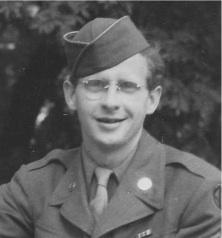
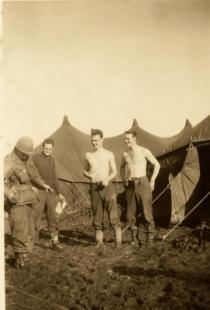
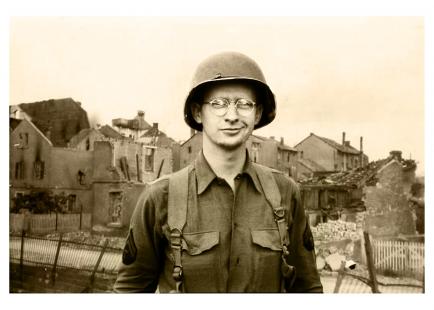
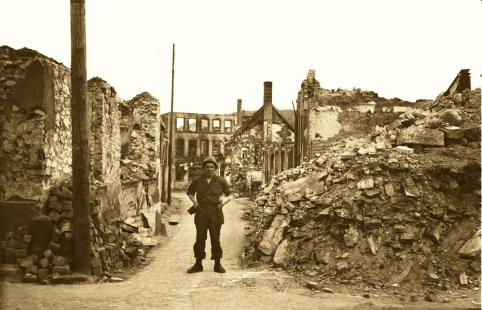
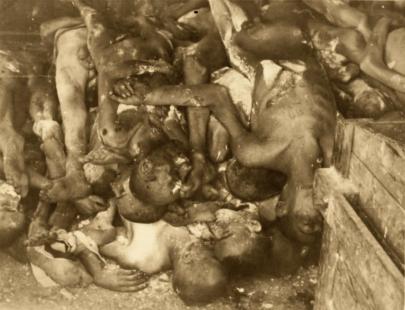
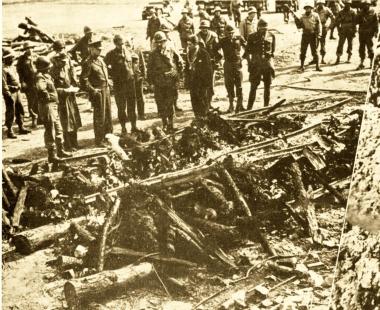
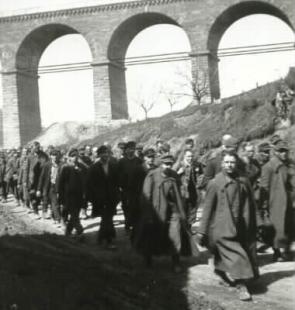

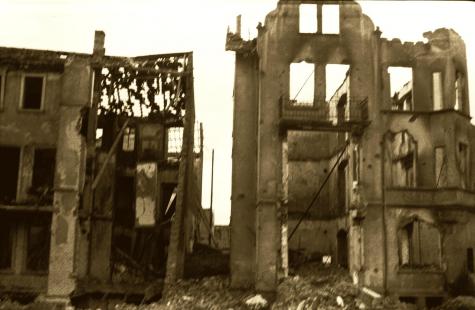
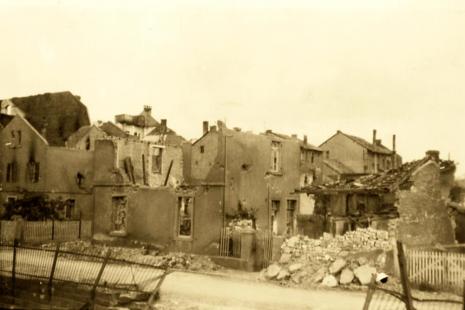

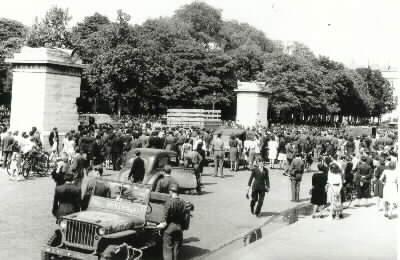
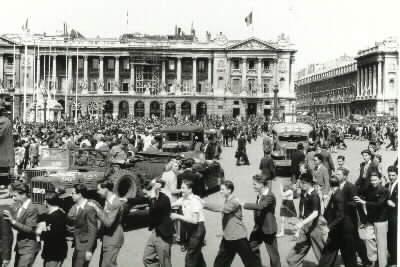
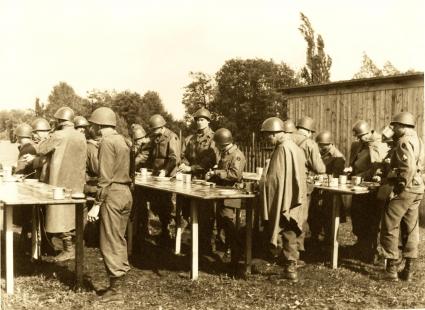
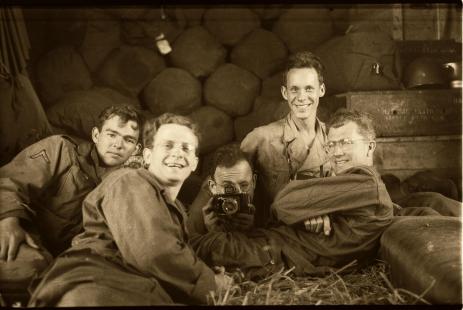
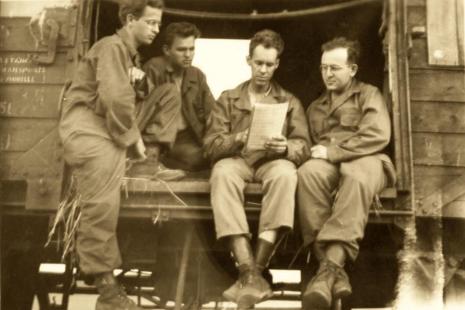
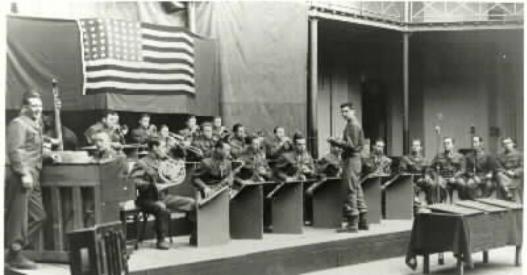
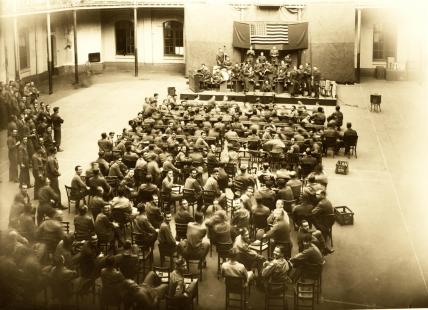

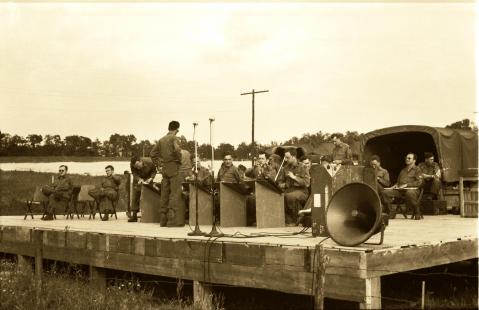
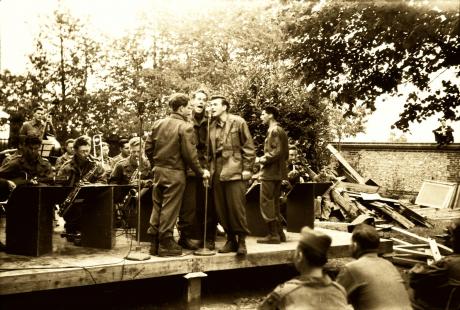
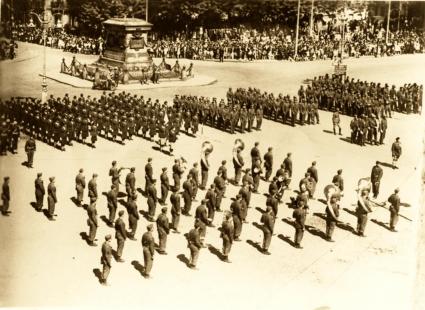
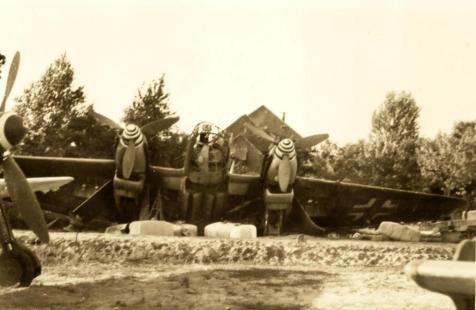
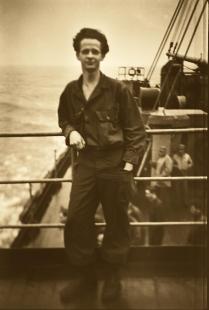
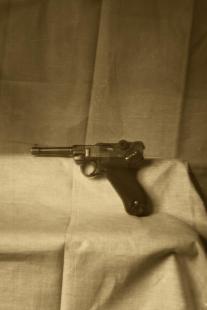
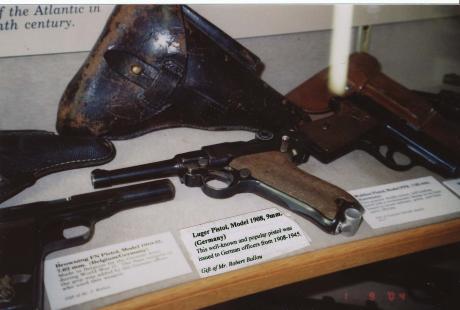
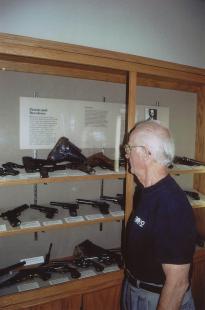
All photos courtesy of Robert Ballou.
Photo 1: Robert Ballou in uniform.
Photo 2: Camp Lucky Strike, Normandy, France (camp had capacity of 60,000 service members), January 1945. L-R: Vernon Noble, Harry Gee, Ben McKleen, Warren Wolf.
Photo 3: Bad Bertrich, Germany, March 1945. Robert Ballou.
Photo 4: Rhaunen, Germany, March 1945. Laverne Silva.
Photo 5: Ohrdruf Concentration Camp, Ohrdruf, Germany. This was the largest concentration camp the Americans had liberated to date. Mr. Ballou's unit liberated it on April 8, 1945.
Photo 6: File photo of Ohrdruf Concentration Camp with General Eisenhower and other prominent American military leaders in attendance, April 1945.
Photo 7: German POWs, Wommen, Germany, April 10, 1945.
Photo 8: Germany in ruins, April 1945.
Photo 9: Germany in ruins, April 1945.
Photo 10: Germany in ruins, April 1945.
Photo 11: Arc de Triomphe, Paris, VE Day (Jour de L'Armistice).
Photo 12: Paris, VE Day.
Photo 13: Place de la Concorde, Paris, VE Day.
Photo 14: American troops in Gotha, Germany, May 1945.
Photo 15: Mr. Ballou, his vocal quartet, and a friend returning to France from Germany on a French '8 or 40' boxcar, May 31-June 3, 1945.
Photo 16: Mr. Ballou and his vocal quartet, May 31-June 3, 1945.
Photo 17: Army jazz/dance band (of which Mr. Ballou's vocal quartet was a part) performing in Rouen, France, June 1945.
Photo 18: Army jazz/dance band, Rouen, France, 1945. In the audience are American troops that would soon be returning home.
Photo 19: Historic clock, Rouen, France, 1945.
Photo 20: Jazz band and quartet performing at different American "cigarette camps," summer 1945.
Photo 21: Vocal quartet at "cigarette camp."
Photo 22: Bastille Day, July 14, 1945. The 89th Infantry Division Band performed
Photo 23: Downed German plane in Bad Kissingen, July 21, 1945.
Photo 24: Going home aboard the U.S.S. Le Jeune on the North Atlantic, March 29, 1946.
Photo 25: German Luger 1908 model. War trophy.
Photo 26: German Luger and case on display at Minnesota Military Museum, Camp Ripley, Minnesota.
Photo 27: Mr. Ballou at Minnesota Military Museum.
Mr. Ballou served in World War II in the European Theater. He served in the U.S. Army from 1943 until 1946. Mr. Ballou grew up in Duluth and graduated from Central High School in 1941. He studied music for two years at Duluth State Teachers College before he enlisted in the Army in 1943.
While in the service but assigned to duty in the United States, he attended Los Angeles City College. He was also an Army musician; he played clarinet and sang vocals.
In Europe, Mr. Ballou served as a military police officer. He was in Germany when the Germans had been defeated. He and his unit sat waiting on the banks of the Elbe River for a Russian unit to meet up with them. As they sat waiting, some of the American servicemen were given furloughs, and Mr. Ballou was one of them.
As a result, he was in Paris on May 8, 1945, VE-Day, when the war in Europe ended with the German surrender. As an amateur photographer, he recorded scenes of French citizens mingling with American troops; the crowds that filled the Champs-Élysée; and celebrations of the end of the war. He recorded ceremonies that day at the Tomb of the Unknown Soldier at the Arc de Triomphe along with the famed Eiffel Tower. Mr. Ballou later photographed the cathedral in Rouen, France, which survived the war.
After the war, Mr. Ballou was a member of the Occupation Army in Germany. He again became an Army musician, playing clarinet with the 89th Division Band and singing in the vocal quartet.
Following his discharge, Mr. Ballou returned to Duluth and helped the government of St. Louis County, Minnesota, set up its print shop and microfilm operations. He later worked in the purchasing department.
Ballou was, like many GIs, a collector of artifacts he came across during the later days of the war. His finds included postcards, photos and French and German currency.
The following story was provided by Mr. Ballou:
R E S T R I C T E D
The Rolling W
Published “on the fly” by the Public Relations Section, 89th Infantry Division
No. 21 Nach Berlin: 115 miles Thursday 12, April ‘45
THE OHRDRUF NIGHTMARE (excerpt)
Every man in the 89th Infantry division should read every word of this two-in-one story. It’s a good story to keep in one’s pocket for re-reading sometimes in the future when one might feel himself “growing soft” about our present enemies.
Though 89th Infantry Division troops had driven the Germans from Ohrdruf, Dr. Thelo Muhlberg still was able to live like a German gentleman. The Americans permitted him to remain with his family and servants in his castle, the entire third and fourth floors were left for his convenience. He was allowed to go downstairs and stroll around the courtyard with Punzei, his Spitz terrier.
Across the road, in the valley below the doctor’s castle,
the men of the 89th began to move through the gates of
the Nord Lager Ohrdruf in company formation. This trip was
designed to show them how the enemy they were fighting
worked. Now they could verify with their own eyes something
that many of them called “propaganda” in the past. But this
time it couldn’t have been prepared in a New York office, for
these very troops had only hours before driven the enemy from
this spot. Now they were going to see one of these ill-famed
concentration camps . . .
Dr. Muhlberg noticed the wide eyes of the American soldiers as they examined his castle and its furnishings. It wasn’t old and dirty and crumbling. It stood upon a little hill in the center of the valley. The view was so commanding that both German and American commanders had chosen this castle for their headquarters.
. . . Every soldier craned his neck as he entered the concentration
camp. Some skinny little men stood by the gate watching them.
Their skin was pulled tight across barren skulls and their eyes were
wide and sunken. It was easy to tell they were Russians and Poles.
They were the thinnest human beings the men of the 89th had ever
seen. Every bone in each face seemed visible, their hands and arms
hung down like sticks by their sides. A rickety barbed wire fence
enclosed about two acres of dismal land, filled with dirty brown and
red barracks . . .
This was the first time enemy troops had been so deep within the Reich. Thelo remembered they had barely crossed the frontier during the last war. Thelo served on a medical board, examining recruits in World War I. When the war ended he returned to the family paint factory at Ohrdruf and to his wife and their sons Eric and Karl.
. . . The bodies were scattered around the barracks. Some were
naked, some were covered with blankets. The Americans said
nothing; some moved away quickly, their faces a little pale. Some
just stood and stared at the shrunken little bodies, the dirty,
plaster-like appearance made the bodies look more like
department-store dummies. . .
. . .But those vacant, staring eyes were not the eyes of dummies. Nor
was there anything unreal about the little holes in the right side of
each neck. One could still distinguish Poles, Russians, French,
Belgians, Dutch, and yes, one American – a young pilot who had
bailed out of his crippled plane near the camp . . .
Dr. Muhlberg did not like the way things were going after the last war. These Democrats promised much but did nothing. The unemployed grew in numbers and people were not buying paint.
. . . One of the skinny little men, speaking Russian, walked up to
the soldiers. A Russian-speaking American asked a question.
“Yes,” said the little man, “I am Russian, and these people were
all known to me. “This one,” indicating a half-hidden body, “was my
best tovarich (comrade).” From this man and others, the Yanks
heard how the camp was operated. Ivan – for that was his name
– had arrived only a few days before. The Germans were frantically
moving their foreign slaves from one area to another. Since his
capture in 1941, Ivan had been shipped all over Europe. He worked
in factories in the Ukraine and in Czechoslovakia, on defense works
in Poland and now in Germany. . .
. . .This was a new concentration camp. Five months before, young
Germans were being trained as officers here. Then suddenly they
were called to the front and the SS moved in. And the boxcars
loaded with slaves began to roll in . . .
Thelo remembered 1932. That was the year he joined the National Socialist Party. That was the year he started to build his castle. The government has sent him several hundred workers, but his factory couldn’t use them all, so Thelo decided to build his castle and used them for that.
. . . The SS men herded the foreigners into the barracks. Two
hundred men were put into each barracks, 25 went into a room,
which previously housed four German noncoms. All furnishings
were removed. Surplus bags filled with straw were on the floor.
All meals were the same – a bowl of stewed turnips, a piece of
bread and a piece of butter. At first streak of light each day the
workers were marched off to labor in the fields. Some worked in
the town . . .
Business grew for Muhlberg after he joined the Nazi party. Orders began to flow in, production rose. By 1935, his castle was finished. Profits began to pile up.
. . . Some of the workers could not stand the strain. When they
quit a guard would come over. He led the worker to a dispensary.
The doctor took his temperature. People who are exhausted
from overwork seldom show a temperature. Such a worker was
rushed outside to a whipping post. The whipping post was a
rack-like table across which the slave was stretched, his arms
tied down, his legs bent in under the table. Then the guard took a
four-foot pole and began to beat the worker over the back. The
beating would continue until the blood flowed. If the victim
screamed he would be beaten until he stopped screaming, which
meant until he became unconscious. From there his body was
hauled to the guardroom, where he was left to die. If he didn’t die
off soon enough he would be carried to the whipping shed, there
he would be clubbed until dead . . .
By 1939, Dr. Muhlberg’s paint was known all over Germany. He had competitors. But Thelo was clever. He played ball with the Nazi’s, met all demands, but volunteered nothing extra. He was satisfied to produce two and a half million kilos of paint a year.
. . .Ivan stopped in front of a little shack and opened the door,
pointing to the pile inside – a heap of human bones, stacked like
cordwood. There was no smell save the smothering odor of lime
that was sprinkled over the bodies and into the wounds. . .
. . .Yes, said Ivan, some of the men were goaded into trying to escape
Then, when caught, the victim was led to a portable gallows and
hung on the spot. . .
Thelo was a little nervous when the war broke out, but his anxiety was smoothed as the Panzers swept across Poland and France. Then the war took another turn and the German legions in Russia and Africa learned defeat. It came as a shock to Thelo; he was caught short on supplies. He secured the goods on the black market and the Gestapo caught him. But money and friends saved him.
. . .in March the SS troops began to grow more cruel. They would
grab workers on any pretext and wrestle with these emaciated
beings. Sometimes the SS men would break a worker’s arm, or
he would clasp the laborer in a bear hug and press until his ribs
caved in. . .
. . .One day the workers were in the field. A plane came overhead;
smoke pouring from its tail. It fell into the woods. The pilot bailed
out. The SS men rushed forward, knelt and took turns shooting
at the aviator as he floated down. The pilot slipped air out of
‘chute’, fell fast and dodged the bullets. But he broke his ankle as
he the ground. The SS men grabbed him and forgot then and there
that he was to be treated as a prisoner of war. At the barracks his
uniform as stripped off and he was branded on the arm like other
inmates of the camp. . .
Thelo began to feel the war when his sons were drafted.They were a little old, Eric being 37 and Karl 35, but it had to be.
. . .As the Americans drew nearer, the guards began to kill more
workers. They fed them less so they would starve faster. They
began to kill 50 to 60 a day. When one of the 89th men asked
where the bodies were, Ivan called his friend, Alexander. Yes,
Alexander knew where the bodies were. He had been there many
times. When the number of very weak had grown large enough,
the Germans piled them into carts and drove them about two
kilometers away. Before they started out, they made the rest of
the workers fall out and run down the road ahead of the carts. The
guards sat a top the trucks and shot at those who couldn’t keep up
the pace. The trucks ran over their bodies.
Yes, Hitler had meant well for Germany, but the men around him had deceived him into doing the wrong things, thought Thelo, as his eyes swept over the site of the murder factory without stopping. He called to Punzei and together they walked contentedly into the castle. The 3,700 sleeping in the pits no longer cared, either.
Source(s):
Albert J. Amatuzio Research Center | Veterans Memorial Hall (vets-hall.org)

